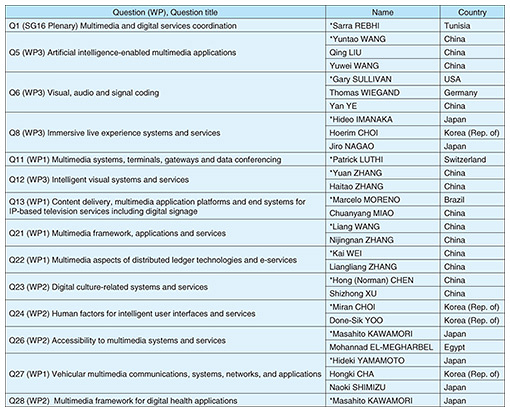 |
|||||||||||
|
|
|||||||||||
|
Global Standardization Activities Vol. 21, No. 4, pp. 83–86, Apr. 2023. https://doi.org/10.53829/ntr202304gls ITU-T Study Group 16 Meeting Report and Recent Development in Standardization of Immersive Live Experience TechnologiesAbstractThe recent meeting of the International Telecommunication Union - Telecommunication Standardization Sector (ITU-T) Study Group (SG) 16 was held in October 2022, with the new management members. An SG vice-chairman and two Working Party chairmen were appointed from Japan. Regarding immersive live experience, four draft documents including one new work item were discussed, and the definition of the descriptor of haptic information was added to one of the documents during the meeting. In the meeting, a Correspondence Group on Metaverse was held and sent a liaison statement to the Telecommunication Standardization Advisory Group (TSAG) asking for TSAG’s decision on whether to start a Focus Group on Metaverse. With the newly appointed director of the Telecommunication Standardization Bureau, Mr. Seizo Onoe, a positive cycle of technology development and dissemination is expected by incorporating industry into the standardization activities of ITU-T. Keywords: ITU-T, Study Group (SG) 16, immersive live experience (ILE) 1. New Study Group 16 administrationThe administrations of Study Groups (SGs) of the International Telecommunication Union - Telecommunication Standardization Sector (ITU-T) are renewed every four years. The Plenipotentiary Conference (PP)*1 decides the general policy for the whole ITU and World Telecommunication Standards Assembly (WTSA)*2 for ITU-T, including appointments of SG chairmen and vice-chairmen. The recent ITU-T SG16 meeting was held between October 17 and 28, 2022. The new SG16 administration under the chairman (re-appointed) was formed as it was the first meeting after WTSA. The chairman and vice-chairmen of SG16 are listed in Table 1. Mr. Yamamoto (OKI) from Japan was appointed as a vice-chairman.
The rapporteurs and associate rapporteurs who lead Questions (Q) and Working Party (WP) chairmen were also appointed during the SG16 meeting. Table 2 lists the WP chairmen. Mr. Yamamoto and Mr. Imanaka (National Institute of Information and Communications Technology (NICT)) from Japan were appointed as WP2 and WP3 co-chairmen, respectively. The rapporteurs and associate rapporteurs are listed in Table 3. Three rapporteurs (Q8 Mr. Imanaka, Q27 Mr. Yamamoto, Q26 and Q28 Mr. Kawamori (Keio University)) and two associate rapporteurs (Q8 the author, Q27 Mr. Shimizu (Mitsubishi Electric)) from Japan were appointed.
2. SG16 meeting topics2.1 Immersive live experienceThe Q8 of SG16 studies immersive live experience (ILE). NTT has been contributing actively to Q8 since the beginning of the Question. Five Recommendations (From ITU-T H.430.1 to H.430.5) have been published thus far. Study on interactive immersive services (IIS) started recently, and NTT proposed to start the draft Recommendation H.ILE-Haptic. Other topics are described below. (1) H.430.3 V2 (Service scenario of ILE) This draft Recommendation explains service scenarios and use cases of ILE. Transport of haptic information and IIS are considered to be added to the document. Descriptions of the relevant service scenarios were revised, and information on the related technologies provided by SG13 was added to the draft Recommendation during the meeting. (2) H.IIS-Reqts (Requirements of IIS) This document defines the requirements of IIS. Consent of the draft was proposed, but it was postponed because a relatively large revision was made to the draft including elaboration and change of sections. (3) H.ILE-Haptic (Media transport protocols, signalling information of haptic transmission for ILE systems) NTT proposed to start this draft Recommendation to add haptic transmission technology to ILE. The current Recommendations on ILE describe transport of video, audio, location, etc., but the draft aims to add the transmission technology of haptic information to achieve even higher sense of immersiveness. Stiffness and other information have been added to the draft along with the definition of the descriptor of haptic information during the meeting. (4) H.IIS-FA (Functional architecture of IIS system) This is a new work item consented to start during the meeting. High-level architecture of IIS and functional architecture are expected to be studied. Details will be discussed in future meetings. 2.2 MetaverseCorrespondence Group (CG) on Metaverse had been held in the previous SG16 meeting (January 2022). Focus Group (FG)*3 on Metaverse was proposed from Japan in this meeting (October 2022). The CG was also held in this meeting, and issues, such as whether to start the FG, the parent group of the FG, name of the FG, were sent to the Telecommunication Standardization Advisory Group (TSAG)*4.
3. Future prospectIn PP-22 [1] held from 26 September to 14 October 2022, Mr. Onoe from Japan (then NTT chief standardization strategy officer) was elected as the next director of the Telecommunication Standardization Bureau at ITU-T. He started his post in January 2023. This appointment is expected to stimulate the telecommunication standardization activities in Japan, resulting in more active discussion in SG16. NTT plans to continue contributing to the work items such as H.ILE-Haptic. Not only the standardization communities but also the market is interested in the metaverse. Collaboration between the industry, who implements technologies, and ITU-T, who deploys technology standards worldwide, is expected to create a positive cycle of technology development and dissemination. Reference
|
|||||||||||












